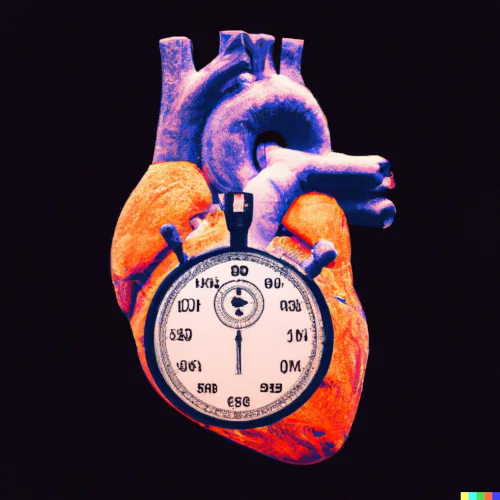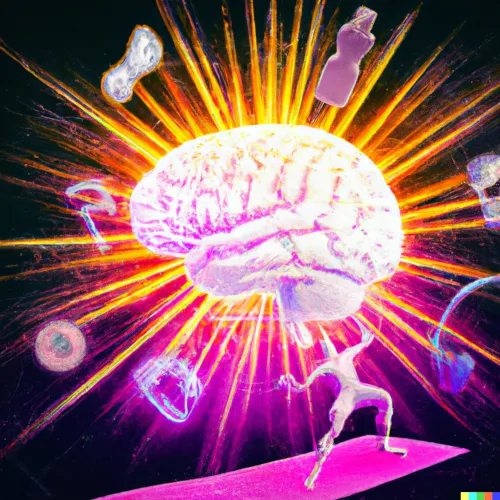Let’s face it – we all lead busy lives, and finding the time to exercise can be quite the challenge. Enter HIIT: a workout routine that’s not only time-efficient but also offers incredible benefits for weight loss and overall fitness. So, what’s the buzz about HIIT, and why should you give it a try? Stick around, and let’s dive into the world of High-Intensity Interval Training.

The concept of HIIT can be traced back to the early 20th century when Finnish long-distance runner Hannes Kolehmainen incorporated interval training into his routine. However, the term “High-Intensity Interval Training” gained popularity in the late 1990s and early 2000s, when researchers began publishing studies showcasing the benefits of this workout method. Over the years, HIIT has evolved, with various protocols emerging, such as Tabata, Little, and Gibala, each with its unique blend of work and rest intervals.
HIIT has attracted numerous famous practitioners, including celebrities and athletes, who swear by its effectiveness. Some well-known figures who incorporate HIIT into their fitness routines are:
- Hugh Jackman: The actor, known for his role as Wolverine in the X-Men series, has credited HIIT as a key component of his workout regimen. Jackman’s routine includes a mix of weight training, functional exercises, and HIIT to achieve his shredded physique.
- Scarlett Johansson: The Black Widow actress has been known to incorporate HIIT workouts into her fitness routine to stay in top shape for her physically demanding roles. Her trainer, Eric Johnson, combines strength training with HIIT circuits to help Johansson achieve her desired results.
- David Beckham: The former soccer star is no stranger to intense training, and HIIT has been part of his fitness journey. Beckham’s HIIT sessions often include treadmill sprints, bodyweight exercises, and agility drills to maintain his athletic prowess.
- Halle Berry: The Oscar-winning actress regularly shares her passion for fitness on social media, and HIIT workouts are a staple in her routine. Berry works with her trainer, Peter Lee Thomas, to incorporate a mix of boxing, strength training, and HIIT for optimal results.
Due to its effectiveness it’s no surprise that this highly versatile training protocol has found its way into the routines of numerous celebrities and athletes, further cementing its place in the fitness world. With its rich history and wide range of applications, HIIT continues to be a popular choice for those seeking weight loss, improved cardiovascular health, and overall fitness.
HIIT for Weight Loss
The effectiveness of HIIT for weight loss has been widely studied, with research demonstrating its superiority over traditional cardio workouts in terms of calorie burn and fat loss. Here are some noteworthy studies that highlight the benefits of HIIT compared to other forms of exercise:

This study examined the effects of a 15-week HIIT program versus a steady-state cardio program on fat loss in young women. The results revealed that the HIIT group experienced significantly greater fat loss compared to the steady-state cardio group.
In this review, Stephen H. Boutcher analyzed multiple studies and concluded that HIIT is more effective for reducing subcutaneous and abdominal body fat compared to other forms of exercise, including moderate-intensity continuous training (MICT) and resistance training.
This systematic review and meta-analysis compared the effects of HIIT and MICT on body composition in overweight and obese adults. The findings showed that both HIIT and MICT were effective in reducing total body fat, but HIIT appeared to be more effective in decreasing visceral fat mass.
These studies showcase the effectiveness of HIIT for weight loss compared to other forms of exercise. By incorporating HIIT into your workout routine, you can experience greater calorie burn and fat loss in less time, making it an efficient and powerful tool for achieving your weight loss goals.
HIIT for Cardiovascular Health
HIIT has a remarkable impact on cardiovascular health, offering benefits that often surpass those of traditional endurance training. The unique nature of HIIT workouts, which involve alternating between high-intensity exercises and recovery periods, can lead to substantial improvements in cardiovascular fitness. Here’s a summary of why HIIT is better and how it works for heart health:
Enhanced Aerobic and Anaerobic Capacity:
One of the key advantages of HIIT is its ability to improve both aerobic (endurance) and anaerobic (short-term, high-intensity) capacity. By challenging the heart and lungs to work harder during the high-intensity intervals, HIIT promotes better oxygen utilization, leading to increased stamina and endurance over time. A study by Gibala et al. (2006) found that HIIT effectively improved both aerobic and anaerobic capacity in participants.
Improved Cardiovascular Function and Reduced Risk Factors:
HIIT has been shown to reduce risk factors associated with cardiovascular disease, such as high blood pressure, cholesterol levels, and blood sugar levels. A study by Tjønna et al. (2008) demonstrated that HIIT led to significant improvements in cardiovascular function, including blood vessel dilation and arterial stiffness, compared to traditional endurance training.
Time-Efficient Cardiovascular Benefits:

One of the most appealing aspects of HIIT is that it provides significant cardiovascular benefits in a shorter amount of time compared to traditional cardio workouts. By engaging in brief, intense exercises followed by recovery periods, individuals can achieve substantial improvements in heart health without spending hours on the treadmill or elliptical. A study by Helgerud et al. (2007) showed that HIIT led to a 40% increase in maximal oxygen uptake (VO2max), a key indicator of cardiovascular fitness, in a relatively short period.
HIIT stands out as a superior form of exercise for cardiovascular health due to its ability to enhance both aerobic and anaerobic capacity, improve cardiovascular function, and reduce risk factors associated with heart disease. Additionally, HIIT’s time-efficient nature makes it an attractive option for those looking to reap heart health benefits without devoting extensive time to traditional cardio workouts.
HIIT for Improved Muscle Tone and Strength
HIIT workouts can have a profound impact on muscle tone and strength, making them an excellent choice for individuals aiming to achieve a well-defined, athletic physique. The combination of high-intensity exercises and brief recovery periods helps build and maintain lean muscle mass while simultaneously enhancing overall strength and endurance. Here’s a closer look at how HIIT targets muscle groups and maximizes results:
Muscle Activation and Full-Body Workouts:
HIIT workouts often involve compound exercises that engage multiple muscle groups simultaneously. This full-body approach not only increases calorie burn but also helps to develop functional strength and muscle balance throughout the body. By incorporating a variety of exercises, such as squats, push-ups, and lunges, HIIT workouts can effectively target and tone different muscle groups.
Resistance and Bodyweight Training:
One of the unique aspects of HIIT is its adaptability to various types of resistance and bodyweight exercises. Combining strength training with HIIT workouts creates an environment where muscles are challenged during high-intensity intervals, promoting muscle growth and increased strength. For instance, incorporating exercises like kettlebell swings, weighted lunges, or pull-ups into a HIIT routine can help develop strength while maintaining the time-efficient nature of HIIT workouts.
Increased Fat Burning and Muscle Retention:
The intensity of HIIT workouts can lead to higher calorie burn and improved fat loss, which can contribute to a leaner, more toned appearance. Additionally, HIIT has been shown to promote muscle retention during weight loss, ensuring that the majority of the weight lost comes from fat stores rather than muscle tissue.

Improved Exercise Performance and Recovery:
Participating in HIIT workouts can lead to improvements in exercise performance, including increased power, speed, and endurance. This translates to better functional movement, reduced risk of injury, and more efficient recovery between workouts. Moreover, the alternating nature of HIIT workouts, which involves high-intensity intervals followed by recovery periods, helps to train the body to recover more rapidly, resulting in enhanced performance during subsequent workouts.
By engaging multiple muscle groups, incorporating resistance and bodyweight training, promoting muscle retention during weight loss, and enhancing exercise performance, HIIT workouts can help individuals achieve a well-rounded and balanced fitness routine. This dynamic approach to exercise can contribute to the development of a lean, strong, and athletic physique.
HIIT for Mental Health and Mood Enhancement
In addition to its numerous physical benefits, HIIT has also been shown to positively impact mental health. Engaging in regular HIIT workouts can help boost mood, reduce stress, and enhance cognitive function. Here’s a deeper look at how HIIT can contribute to improved mental well-being:
Mood Enhancement and Endorphin Release:
Participating in HIIT workouts can lead to the release of endorphins, the body’s natural “feel-good” chemicals. These endorphins can help alleviate feelings of stress, anxiety, and depression, contributing to improved mood and emotional well-being. Additionally, the sense of accomplishment and satisfaction that comes from completing a challenging workout can further enhance one’s mood and self-esteem.
Stress Reduction and Cortisol Management:
Stress can have detrimental effects on both physical and mental health. HIIT workouts have been shown to help manage stress by reducing cortisol levels, the body’s primary stress hormone. A study by Ziemann et al. (2011) demonstrated that participants who engaged in HIIT experienced a decrease in cortisol levels and reported lower levels of perceived stress.
Enhanced Cognitive Function and Brain Health:
Regular physical activity, including HIIT, has been linked to improved cognitive function and overall brain health. Engaging in HIIT workouts can help increase the production of brain-derived neurotrophic factor (BDNF), a protein that supports the growth and maintenance of brain cells. A study by Saucedo Marquez et al. (2015) found that participants who performed HIIT experienced increased BDNF levels, suggesting that HIIT can contribute to better cognitive function and brain health.

Improved Sleep Quality and Mood Regulation:
Adequate sleep is essential for maintaining optimal mental health. Regular HIIT workouts can contribute to better sleep quality by promoting the release of sleep-inducing hormones, such as melatonin, and by helping to regulate the body’s internal clock. Improved sleep, in turn, can lead to enhanced mood regulation and a greater sense of overall well-being.
HIIT can play a vital role in promoting mental health and well-being. By boosting mood, reducing stress, enhancing cognitive function, and improving sleep quality, HIIT workouts can have a significant impact on overall mental wellness. Incorporating HIIT into a regular fitness routine can not only help individuals achieve their physical goals but also contribute to a happier, healthier state of mind.
Final Thoughts
In conclusion, High-Intensity Interval Training (HIIT) offers an array of benefits that make it a powerful and efficient choice for those seeking to improve their health, fitness, and overall well-being. Its time-efficient nature, combined with its ability to deliver impressive results in weight loss, cardiovascular health, muscle tone and strength, and mental wellness, makes HIIT an attractive and adaptable option for individuals with diverse fitness goals and busy lifestyles. Furthermore, HIIT’s rich history, varied protocols, and celebrity endorsements attest to its effectiveness and enduring popularity.
By incorporating HIIT into your fitness routine, you can not only achieve your weight loss and fitness objectives but also enjoy the benefits of improved mental health and a greater sense of satisfaction and accomplishment. In a world where time is a precious commodity, HIIT emerges as an ideal solution to help you make the most of your workouts, transforming your body and mind for a healthier, happier, and more balanced life.

Flavia Kalebic – hiitathome.co.uk
I’m a dedicated and passionate personal trainer with over 7 years of experience helping clients transform their lives through fitness. I love high-intensity interval training (HIIT), and I’ve mastered the art of creating efficient and powerful workouts that cater to my clients’ unique goals and needs. With a strong focus on mental and physical well-being, I’m committed to helping others experience the incredible benefits that come from incorporating HIIT into their daily routines.
Read my blog here.


